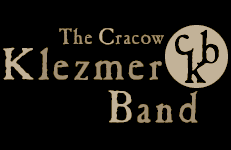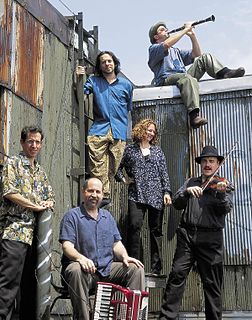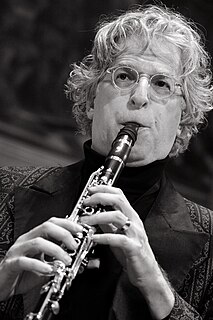
Klezmer is an instrumental musical tradition of the Ashkenazi Jews of Central and Eastern Europe. The essential elements of the tradition include dance tunes, ritual melodies, and virtuosic improvisations played for listening; these would have been played at weddings and other social functions. The musical genre incorporated elements of many other musical genres including Ottoman music, Baroque music, German and Slavic folk dances, and religious Jewish music. As the music arrived in the United States, it lost some of its traditional ritual elements and adopted elements of American big band and popular music. Among the European-born klezmers who popularized the genre in the United States in the 1910s and 1920s were Dave Tarras and Naftule Brandwein; they were followed by American-born musicians such as Max Epstein, Sid Beckerman and Ray Musiker.
The Flying Bulgars was a Toronto-based Canadian folk music band, which played music rooted in the Jewish music of Eastern Europe. This is traditionally folk music; the band added elements of rock, jazz and salsa. 'Bulgar' in the group's name refers to a dance form, not an ethnic group.

A badchen or badkhn is a type of Ashkenazic Jewish wedding entertainer, poet, sacred clown, and master of ceremonies originating in Eastern Europe, with a history dating back to at least the seventeenth century. The badchen was an indispensable part of the traditional Jewish wedding in Europe who guided the bride and groom through the stages of the ceremony, act as master of ceremonies, and sing to the bride, groom and in-laws with the accompaniment of klezmer musicians. They also had a traditional role on holidays such as Hanukkah or Purim. Today they are primarily found in Chassidic communities.

The Cracow Klezmer Band was a Polish jazz quartet formed by accordionist and composer Jarosław Bester in 1997 in the city of Kraków, and recorded for Tzadik Records. The group performed at Jewish Culture festivals in Hungary, Finland, Poland, Prague, and the Czech Republic. Its sound was different from what most people would consider to be traditional klezmer music — instead of danceable versions of traditional Yiddish songs, and free-form fantasies, and laments, The Cracow Klezmer Band played often dark and brooding but soulful and dynamic original virtuoso compositions instead in the klezmer form. Some songs could be considered dance pieces, but there were none of the traditional Bulgars, Freylekhs or Horas.

Meyer Myron "Mickey" Katz was an American musician and comedian. He was the father of actor Joel Grey and paternal grandfather of actress Jennifer Grey.

Abe Schwartz was a well-known klezmer violinist, composer, Yiddish theater and ethnic recordings bandleader from the 1910s to the 1940s. In his various orchestras, he recorded many of the leading klezmer musicians of the early twentieth century, including Naftule Brandwein and Dave Tarras.
The Klezmorim, founded in Berkeley, California, in 1975, was the world's first klezmer revival band, widely credited with spearheading the global renaissance of klezmer in the 1970s and 1980s. Initially featuring flute and strings—notably the exotic fiddling of co-founder David Skuse—the ensemble reorganized into a "loose, roaring, funky" brass/reed/percussion band fronted by co-founder Lev Liberman's saxophones and founding member David Julian Gray's clarinets. As a professional performing and recording ensemble focused on recreating the lost sounds of early 20th century klezmer bands, The Klezmorim achieved crossover success, garnering a Grammy nomination in 1982 for their album Metropolis and selling out major concert venues across North America and Europe, including Carnegie Hall and L'Olympia in Paris. The band performed steadily until 1993, regrouping in 2004 for a European tour.

The Klezmatics are an American klezmer music group based in New York City, who have achieved fame singing in several languages, most notably mixing older Yiddish tunes with other types of more contemporary music of differing origins. They have also recorded pieces in Aramaic and Bavarian.
The Fabrangen Fiddlers is an American Jewish folk music band. Founded in 1971, the Washington, DC-area group was the first music collective devoted to the rediscovery of Jewish folk music and the development of new Jewish liturgical folk music.

David Krakauer is an American clarinetist who performs klezmer, jazz, classical music, and avant-garde improvisation.

Joel Rubin is an American clarinetist, Klezmer musician, ethnomusicologist, and scholar of Jewish music. Since becoming involved in the Klezmer revival in the late 1970s, he has been researching, teaching and performing Klezmer music and related genres. He has been a member of, or performed with, such groups as Brave Old World, the Joel Rubin Ensemble, and Veretski Pass.
Alicia Svigals is an American violinist and composer. A co-founder of the Grammy-winning band The Klezmatics, she is considered by many to be the world's foremost living klezmer fiddler.

Andy Statman is a noted American klezmer clarinetist and bluegrass/newgrass mandolinist.
Hankus Netsky is an American multi-instrumentalist, composer, and ethnomusicologist. He chairs the Contemporary Improvisation Department at the New England Conservatory. Netsky is founder and director of the Klezmer Conservatory Band, an internationally renowned Yiddish music ensemble, and serves as research director of the Klezmer Conservatory Foundation, a non-profit organization dedicated to the preservation and perpetuation of traditional Eastern European Jewish music.

Michael Alpert is a klezmer musician and Yiddish singer, songwriter, multi-instrumentalist, scholar and educator who has been called a key figure in the klezmer revitalization of the 1970s and 1980s. He has played in a number of groups since that time, including The An-Sky Ensemble, Brave Old World, Khevrisa, Kapelye, The Brothers Nazaroff and Voices of Ashkenaz, and collaborated with clarinetist David Krakauer, hip-hop artist Socalled, singer/songwriter Daniel Kahn and bandurist Julian Kytasty. Alpert is also a pioneering teacher and researcher of Yiddish traditional dance and has been central to restoring Yiddish dance to its time-honored place alongside klezmer music as a key component of East European Jewish expressive culture. He is the recipient of a 2015 National Heritage Fellowship awarded by the National Endowment for the Arts, the United States government's highest lifetime honor to its folk and traditional artists.

Mames Babegenush is a Danish Klezmer band formed in 2004 in Copenhagen.
Mames Babegenush is the East meeting the North. Strong Scandinavian roots merging with the vibrant dance music of Eastern Europe. From the great ambience of Nordic pine trees to lively weddings in Romania the music of Mames Babegenush gives a sense of both melancholy and ecstatic joy. In the beginning doing quite traditional klezmer music—with inspiration from artists such as Naftule Brandwein, Abe Schwartz and Dave Tarras—but has increasingly developed their own sound.
Breslov Bar Band is an American experimental klezmer band based in Brooklyn, New York. Formed in 2009 by bandleader Binyomin Ginzberg, the band has released three albums, Have No Fear (2010), Happy Hour (2013), and Holy Chutzpah (2022). They are noted for their experimental interpretations of traditional Breslov nigunim.

Amsterdam Klezmer Band, sometimes referred to as AKB, is a Dutch-Jewish musical group created in 1996 in Amsterdam. The band plays Yiddish and Klezmer music, but also incorporates sounds from Balkan, jazz, Romani, and hip-hop music. The band has described itself as a "mini brass band", but features prominent vocals as well.
The Maxwell Street Klezmer Band is a Chicago-based klezmer ensemble. It was founded by Lori Lippitz in 1983 and is directed by violinist Alex Koffman. The band's educational and outreach focus led to the establishment of the Klezmer Music Foundation, which continues to support Maxwell Street Klezmer Band among other professional and amateur groups. Maxwell Street Klezmer Band has performed and toured across the United States, United Kingdom and Europe. Notable performances have also included those at Carnegie Hall and alongside the Lyric Opera of Chicago in 2014. In addition to performing on stage, Maxwell Street Klezmer Band also plays for weddings, bar/bat mitzvah ceremonies, Jewish community celebrations, and other events.

Jeremiah Hescheles was a Yiddish-language modernist poet, journalist, and Klezmer violinist. Because of his sharp memory and varied life experiences, he was an important resource for researchers of Yiddish culture and Klezmer music in the late twentieth century.











